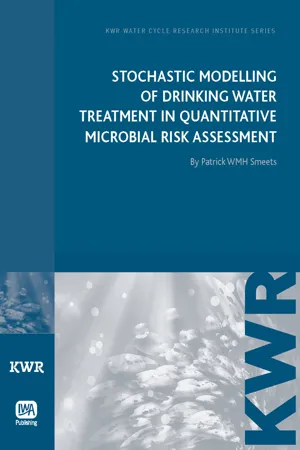
Stochastic Modelling of Drinking Water Treatment in Quantitative Microbial Risk Assessment
- 196 pages
- English
- PDF
- Available on iOS & Android
Stochastic Modelling of Drinking Water Treatment in Quantitative Microbial Risk Assessment
About This Book
Special Offer: KWR Drinking Water Treatment Set - Buy all five books together and save a total £119!
Safe drinking water is a basic need for all human beings. Preventing microbial contamination of drinking water is of primary concern since endemic illness and outbreaks of infectious diseases can have significant social and economic consequences. Confirming absence of indicators of faecal contamination by water analysis only provides a limited verification of safety. By measuring pathogenic organisms in source water and modelling their reduction by treatment, a higher level of drinking water safety can be verified.
This book provides stochastic methods to determine reduction of pathogenic microorganisms by drinking water treatment. These can be used to assess the level and variability of drinking water safety while taking uncertainty into account. The results can support decisions by risk managers about treatment design, operation, monitoring, and adaptation. Examples illustrate how the methods can be used in water safety plans to improve and secure production of safe drinking water.
More information about the book can be found on theWater Wikiin an article written by the author here: http://www.iwawaterwiki.org/xwiki/bin/view/Articles/Quantifyingmicro-organismremovalforsafedrinkingwatersupplies
Frequently asked questions
Information
Table of contents
- Half Title
- Title
- Copyright
- Contents
- Acknowledgements
- Summary
- Chapter 1: Introduction
- Chapter 2: A stochastic pathogen reduction model for full-scale treatment
- Chapter 3: How can the UK statutory Cryptosporidium monitoring be used for quantitative risk assessment of Cryptosporidium in drinking water?
- Chapter 4: Inactivation of Escherichia coli by ozone under bench-scale plug flow and full-scale hydraulic conditions
- Chapter 5: Improved methods for modelling drinking water treatment in quantitative microbial risk assessment; a case study of Campylobacter reduction by filtration and ozonation
- Chapter 6: On the variability and uncertainty in quantitative microbial risk assessment of drinking water
- Chapter 7: Practical applications of quantitative microbial risk assessment for water safety plans
- Chapter 8: General discussion